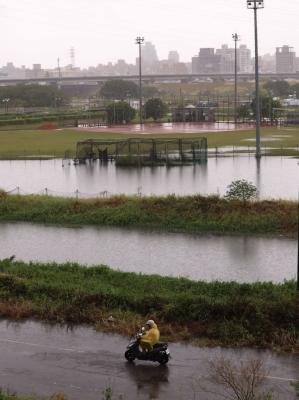The Taipei City Government plans to make the Taipei Second Funeral Parlor the nation’s first “environmentally friendly” funeral home by using the energy produced from cremations to generate electricity for its air conditioning system.
The parlor, which was rebuilt and inaugurated in February last year, was built in accordance with the Ministry of the Interior’s green construction program.
For the comfort of mourners, the parlor management office of the city’s Department of Social Welfare Affairs began installing air conditioners in August. The units will reuse the heat generated by cremations.
Office director Hung Ying-hui (洪英輝) said the office would use heat transfer machines to transform the heat from the cremations into electricity.
The project cost about NT$7.7 million (US$230,000). Starting next month, the air conditioning system in the family waiting room and offices will run on the recycled energy, he said.
The parlor is the only public funeral home with cremation services in Taipei and performs an average of 52 cremations a day. The recycled energy should be sufficient for the air conditioning system.
Democratic Progressive Party (DPP) Taipei City Councilor Chuang Ruei-hsiung (莊瑞雄) yesterday challenged the office’s plan and urged it to take public perceptions into consideration.
“I admire the city government for having such a creative idea, but for family members, it is just creepy to have air conditioning generated from burning bodies,” he said.
Chuang said the energy could be put to other purposes out of respect for the feelings of the mourners.
In response, Hung said the air conditioning system was installed because so many family members had complained that it was too hot in the waiting room during the summer.
“The air conditioning system is operated with recycled energy, and we can also look at it as the goodwill of the deceased,” he said.
Department commissioner Huang Lu Ching-ru (黃呂錦茹) said the department would discuss the matter with the Public Works Department, which did the construction, and look for alternatives.

TRAFFIC SAFETY RULES: A positive result in a drug test would result in a two-year license suspension for the driver and vehicle, and a fine of up to NT$180,000 The Ministry of Transportation and Communications is to authorize police to conduct roadside saliva tests by the end of the year to deter people from driving while under the influence of narcotics, it said yesterday. The ministry last month unveiled a draft of amended regulations governing traffic safety rules and penalties, which included provisions empowering police to conduct mandatory saliva tests on drivers. While currently rules authorize police to use oral fluid testing kits for signs of drug use, they do not establish penalties for noncompliance or operating procedures for officers to follow, the ministry said. The proposed changes to the regulations require

The Executive Yuan yesterday announced that registration for a one-time universal NT$10,000 cash handout to help people in Taiwan survive US tariffs and inflation would start on Nov. 5, with payouts available as early as Nov. 12. Who is eligible for the handout? Registered Taiwanese nationals are eligible, including those born in Taiwan before April 30 next year with a birth certificate. Non-registered nationals with residence permits, foreign permanent residents and foreign spouses of Taiwanese citizens with residence permits also qualify for the handouts. For people who meet the eligibility requirements, but passed away between yesterday and April 30 next year, surviving family members

Taipei, New Taipei City, Keelung and Taoyuan would issue a decision at 8pm on whether to cancel work and school tomorrow due to forecasted heavy rain, Keelung Mayor Hsieh Kuo-liang (謝國樑) said today. Hsieh told reporters that absent some pressing reason, the four northern cities would announce the decision jointly at 8pm. Keelung is expected to receive between 300mm and 490mm of rain in the period from 2pm today through 2pm tomorrow, Central Weather Administration data showed. Keelung City Government regulations stipulate that school and work can be canceled if rain totals in mountainous or low-elevation areas are forecast to exceed 350mm in

China Airlines Ltd (CAL) yesterday morning joined SkyTeam’s Aviation Challenge for the fourth time, operating a demonstration flight for “net zero carbon emissions” from Taiwan Taoyuan International Airport to Bangkok. The flight used sustainable aviation fuel (SAF) at a ratio of up to 40 percent, the highest proportion CAL has achieved to date, the nation’s largest carrier said. Since April, SAF has become available to Taiwanese international carriers at Taipei International Airport (Songshan airport), Kaohsiung International Airport and Taoyuan airport. In previous challenges, CAL operated “net zero carbon emission flights” to Singapore and Japan. At a ceremony at Taoyuan airport, China Airlines chief sustainability